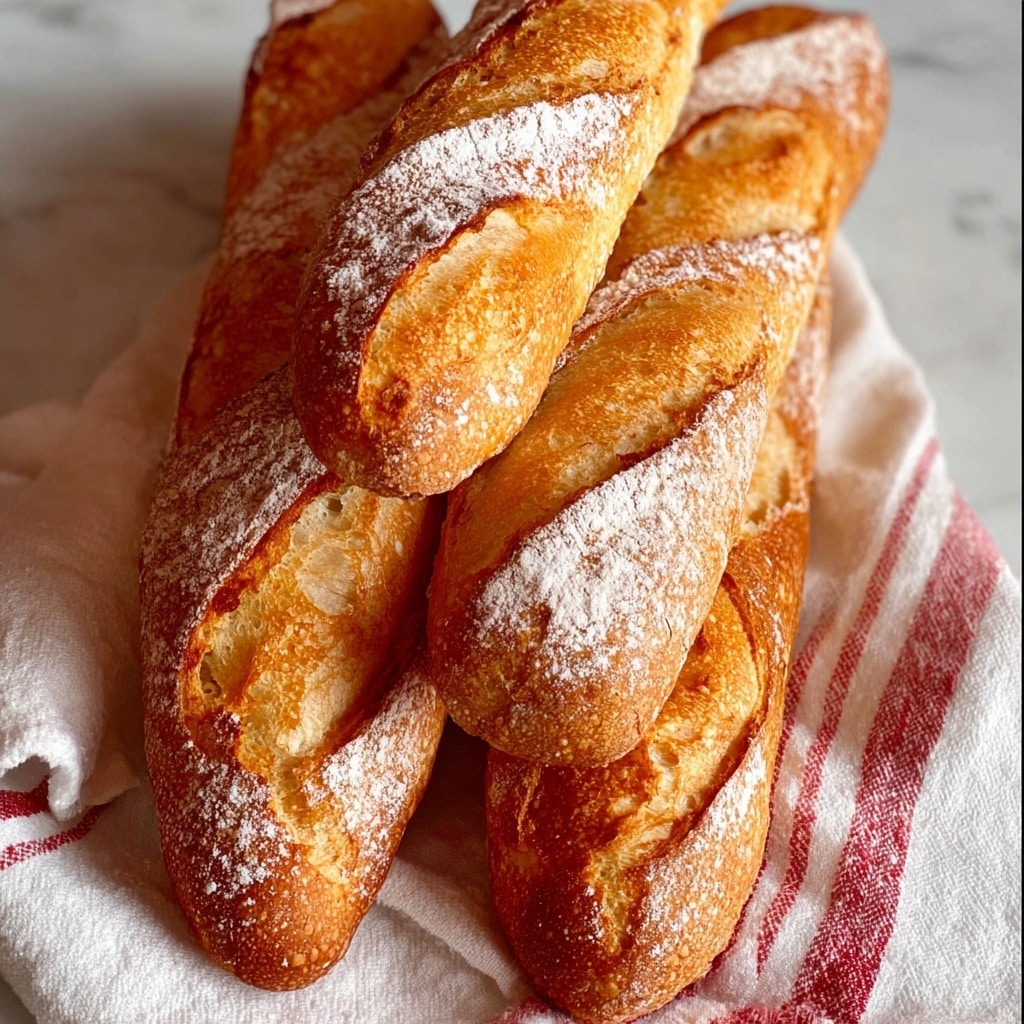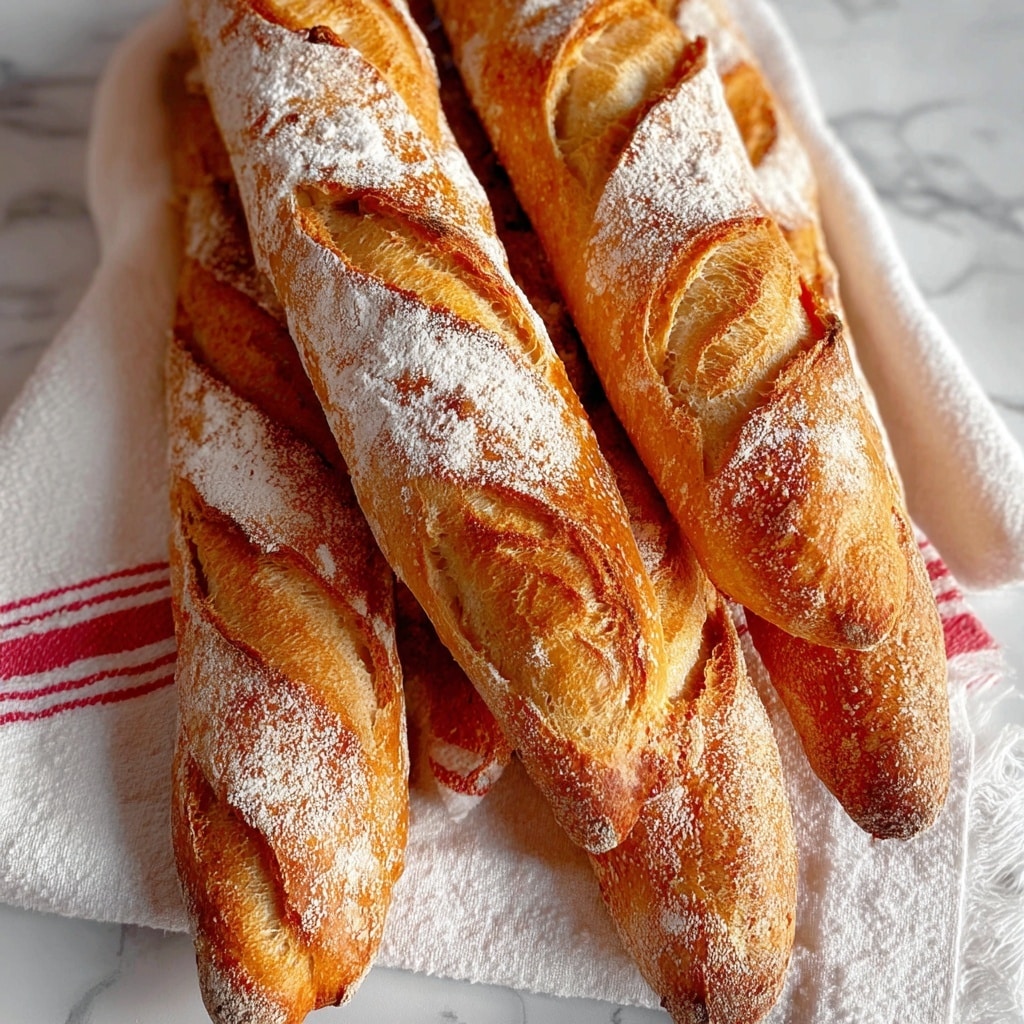If you’ve ever dreamed of baking your own bakery-quality bread at home, look no further than this Classic Crusty French Baguettes Recipe. There’s something truly magical about that golden, crackly crust giving way to a tender, airy crumb inside. This recipe brings the heart of a French boulangerie right to your kitchen, with simple ingredients and straightforward steps that reward you with two perfect, rustic baguettes. No fancy equipment needed—just a bit of patience and love for homemade bread. Once you try this Classic Crusty French Baguettes Recipe, you’ll wonder how you ever bought baguettes from a store before.
Ingredients You’ll Need
The beauty of this Classic Crusty French Baguettes Recipe lies in its simplicity. Each ingredient plays a crucial role in creating that wonderful texture, deep flavor, and stunning color that define an authentic French baguette.
- Bread flour (3 ½ cups): Provides the perfect protein content for strong gluten development, giving the baguette its chewy, airy structure.
- Salt (1 ½ teaspoons): Enhances flavor and controls yeast activity for balanced fermentation.
- Active dry yeast (2 ¼ teaspoons): Responsible for that lovely rise and deliciously subtle yeast flavor.
- Warm water, about 110°F (1 ¼ cups): Activates the yeast and hydrates the flour to form the dough.
- Additional flour for dusting: Keeps the dough from sticking during kneading and shaping.
- Ice cubes: Added to the oven to create steam, essential for developing the crust’s signature crispness.
How to Make Classic Crusty French Baguettes Recipe
Step 1: Combine Dry Ingredients
Start by mixing your bread flour and salt together in a large bowl. This ensures the salt is well distributed so it won’t kill the yeast later on, and gives you a dry base to blend in your yeast mixture smoothly.
Step 2: Activate the Yeast
In a small bowl, dissolve the active dry yeast in the warm water. Let it sit for 5 to 10 minutes until it’s foamy and bubbly—this little proof of life guarantees a lively dough and a great rise.
Step 3: Form the Dough
Pour the yeast mixture into the flour and salt mix. Stir everything together until a shaggy dough forms. At first, it looks messy and uneven—but don’t worry, this is exactly as it should be.
Step 4: Knead Until Smooth and Elastic
Transfer your dough to a lightly floured surface and knead it for 8 to 10 minutes. This step develops the gluten, making your baguettes chewy yet tender. You’ll notice the dough becoming soft, smooth, and stretchy.
Step 5: First Rise
Place the dough in a lightly oiled bowl and cover with a damp cloth. Let it rise in a warm spot for about an hour until it doubles in size. This resting period lets the yeast work its magic, infusing your dough with flavor and lightness.
Step 6: Shape Your Baguettes
Punch down the risen dough gently to release air bubbles. Divide it into two equal portions, then shape each piece into a long, thin loaf—the classic baguette form. Place them on a parchment-lined baking sheet or in a baguette pan for even baking.
Step 7: Final Rise
Cover the shaped dough loosely and let it rise again for 30 to 45 minutes, until puffy and ready to bake. This second rise is crucial for that airy interior crumb.
Step 8: Prepare for Baking
Preheat your oven to 475°F. Just before baking, make several diagonal slashes across the tops of the baguettes with a sharp knife—these cuts help your bread expand and form that iconic look during baking.
Step 9: Bake with Steam
Place a metal pan filled with ice cubes on the bottom rack of your oven to create steam. This steam is key for a crust that is extra crisp and beautifully golden. Bake the baguettes for 20 to 25 minutes until they’re chestnut brown and the crust snaps when tapped.
Step 10: Cool Before Slicing
Once baked, cool your baguettes on a wire rack. This rest time lets the crumb set properly, so each slice achieves that perfect balance of tenderness and structure.
How to Serve Classic Crusty French Baguettes Recipe

Garnishes
Nothing beats fresh butter melted into a warm slice, but you can also sprinkle some flaky sea salt or fresh herbs like rosemary for an aromatic twist. A simple brush of garlic butter enhances the flavor and adds a savory depth perfect for sharing.
Side Dishes
Classic French baguettes shine beside a steaming bowl of soupe à l’oignon or alongside a crisp salade niçoise. They’re also fantastic with cheese boards, charcuterie, or paired with olive oil and balsamic vinegar for dipping.
Creative Ways to Present
Turn your baguettes into sandwiches filled with fresh ingredients like ham, aged cheese, and mustard, or slice them into crostini topped with tomato bruschetta. For breakfast, toast thick slices and drizzle with honey and ricotta for a delightful treat.
Make Ahead and Storage
Storing Leftovers
Store leftover baguettes loosely wrapped in a linen or paper bag to maintain crustiness while preventing them from becoming too hard. Avoid plastic bags, which trap moisture and soften the crust.
Freezing
If you want to keep your baguettes fresh longer, freeze whole or sliced loaves in airtight bags. When you’re ready to enjoy them, thaw at room temperature wrapped in a clean cloth to revive their texture.
Reheating
For a refreshed crust and warm interior, sprinkle the baguette lightly with water and bake it at 350°F for 5 to 10 minutes. This quick crisp-up will remind you of freshly baked bread right from a French bakery.
FAQs
Can I use all-purpose flour instead of bread flour?
While bread flour is ideal for that chewy texture due to its higher protein content, all-purpose flour can be used in a pinch. Just expect a slightly softer crumb and less crusty exterior.
What’s the purpose of adding ice cubes to the oven?
The ice cubes create steam in the oven, which delays crust formation and helps the bread expand fully during baking. It also contributes to a crisp, shiny crust that’s signature to French baguettes.
How long can I let the dough rise?
The recipe calls for about an hour for the first rise and 30-45 minutes for the second, but you can also do a slow, overnight fermentation in the fridge. This longer fermentation deepens the flavor and improves the baguette’s texture.
Can I make this recipe without a baguette pan?
Absolutely! Baking on a parchment-lined baking sheet works just fine. The baguette pan helps maintain shape but isn’t necessary for delicious results.
Why should I make diagonal slashes before baking?
These slashes allow the bread to expand properly as it bakes, letting steam escape and creating the classic rustic look. Plus, they add a lovely texture contrast on the crust.
Final Thoughts
There is something so satisfying about baking your own Classic Crusty French Baguettes Recipe that you just cannot buy in stores—the aroma filling your kitchen, the golden crust cracking under your fingertips, and that tender, airy crumb inside. This recipe is a celebration of simple ingredients coming together through patient, loving preparation. Give it a try and soon you’ll have fresh, irresistible baguettes that will impress your family and friends at any table.
Print
Classic Crusty French Baguettes Recipe
- Prep Time: 20 minutes
- Cook Time: 25 minutes
- Total Time: 2 hours (including rising time)
- Yield: 2 baguettes
- Category: Bread
- Method: Baking
- Cuisine: French
- Diet: Vegan
Description
This Classic Crusty French Baguette recipe guides you through creating authentic, golden brown, artisan-style baguettes with a crisp crust and tender crumb. Perfect for sandwiches or enjoying with butter, these baguettes are made with simple ingredients and baked to perfection using steam to develop their signature texture.
Ingredients
For the Dough
- 3 ½ cups bread flour
- 1 ½ teaspoons salt
- 2 ¼ teaspoons active dry yeast
- 1 ¼ cups warm water (about 110°F)
For Baking
- Additional flour for dusting
- Ice cubes (for steam in oven)
Instructions
- Mix Dry Ingredients: In a large bowl, combine the bread flour and salt thoroughly to distribute the ingredients evenly.
- Activate Yeast: In a small bowl, dissolve the active dry yeast in warm water (about 110°F). Let it sit for 5–10 minutes until it becomes foamy, indicating the yeast is active.
- Form Dough: Pour the yeast mixture into the flour mixture and stir until a shaggy dough forms. This initial mixing brings the ingredients together before kneading.
- Knead Dough: Transfer the dough to a lightly floured surface and knead for 8–10 minutes until it becomes smooth and elastic, which helps develop the gluten for structure.
- First Rise: Place the kneaded dough in a lightly oiled bowl, cover it with a damp cloth, and let it rise for about 1 hour or until it doubles in size. This fermentation process builds flavor and texture.
- Shape Baguettes: Punch down the dough to release air, divide it into two equal pieces, and shape each into a long baguette. Place them on a parchment-lined baking sheet or in a baguette pan.
- Second Rise: Cover the shaped dough loosely and let it rise again for 30–45 minutes until puffy, which ensures a light crumb inside.
- Preheat Oven: Preheat your oven to 475°F (245°C) to achieve a hot baking environment necessary for crust development.
- Make Slashes: Just before baking, use a sharp knife to make several diagonal slashes across the tops of the baguettes. This allows steam to escape and encourages expansion during baking.
- Prepare Steam: Place a few ice cubes in a metal pan on the lower rack of the oven to create steam, which helps cultivate a crisp, shiny crust.
- Bake: Bake the baguettes for 20–25 minutes until they turn golden brown and develop a crusty exterior.
- Cool: Remove the baguettes from the oven and cool them on a wire rack before slicing to set the crumb structure.
Notes
- For an even crispier crust, spritz the baguettes with water just before placing them in the oven.
- Letting the dough ferment overnight in the fridge will deepen the flavor.









